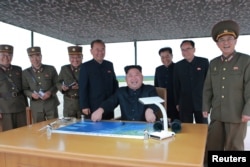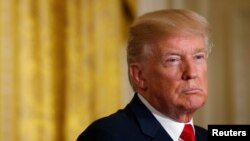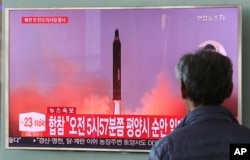U.S. President Donald Trump says "talking is not the answer" when it comes to dealing with the threat of North Korea, following the country's most recent ballistic missile test.
Trump wrote on Twitter Wednesday morning, "The U.S. has been talking to North Korea, and paying them extortion money, for 25 years. Talking is not the answer!"
North Korea has acknowledged firing a ballistic missile over Japan, saying it was to counter current joint exercises by South Korea and the United States.
In a Wednesday morning dispatch from Pyongyang, the official Korean Central News Agency (KCNA) quoted leader Kim Jong Un saying the drill for the launch of the Hwasong-12 intermediate-range ballistic missile was "like a real war" and the first step by North Korea’s military for operations in the Pacific and "a meaningful prelude to containing Guam."
South Korean President Moon Jae-in and Japanese leader Shinzo Abe agreed in a phone call Wednesday that maximum pressure needs to be applied in order to get North Korea to engage in dialogue to resolve the ongoing crisis.
“President Moon said that launching an intermediate range ballistic missile to fly over Japan's airspace was not a simple provocation, but violent conduct to a neighboring country,” South Korean presidential spokesman Park Soo-hyun said.
China's Foreign Minister Wang Yi told reporters Wednesday that China is working with the other members of the U.N. Security Council and hopes those efforts can help peacefully resolve the nuclear crisis.
President Donald Trump said in a Tuesday statement that “all options are on the table” following the latest North Korean missile launch.
North Korea “has signaled its contempt for its neighbors, for all members of the United Nations, and for minimum standards of acceptable international behavior,” Trump said in a statement released by the White House.
Early Wednesday, The U.S. Navy shot down a medium-range ballistic missile off the coast of Hawaii as part of a test of defense systems Wednesday, officials said.
A navy statement said sailors aboard a U.S. vessel "successfully conducted a complex defense flight test.”
UN Security Council
Speaking during an emergency session of the U.N. Security Council Tuesday evening, U.S. Ambassador Nikki Haley said Pyongyang had violated every single Security Council resolution, and that the world was united against its actions.
"It is time for the North Korean regime to recognize the danger they are putting themselves in," Haley said. "The United States will not allow their lawlessness to continue, and the rest of the world is with us."
Both the Chinese and Russian envoys emphasized that there was no military solution to the issue.
The Security Council held two hours of closed consultations on the situation and then issued a statement that "strongly condemns" the recent launch.
"The Security Council further condemns the DPRK for its outrageous actions and demands that the DPRK immediately cease all such actions," said Egyptian Ambassador Amr Aboulatta, who is council president this month. He referred to North Korea by its official acronym.
The council also demanded that Pyongyang not conduct any further ballistic missile launches and comply fully with its obligations under numerous council resolutions, including the most recent, adopted on August 5. That demand looked set to be ignored as media reported that the North Korean leader said the country should conduct more missile tests into the Pacific Ocean.
U.S. intelligence officials said they saw few signs that Pyongyang was likely to be deterred.
"North Korea has been conducting an unprecedented level of testing since early 2016 and we have not seen anything in their defiant posture to suggest that has changed," one official told VOA on condition of anonymity.
U.S. defense officials said the North Korean missile, launched Tuesday from an air base near Pyongyang, landed in the Pacific Ocean, about 930 kilometers east of Japan.
WATCH: Ambassador Nikki Haley on North Korea
The missile did not pose any threat to North America or to the Pacific Island of Guam, which North Korea has threatened in the past, U.S. officials confirmed. Still, the launch heightened concerns about the increasingly rapid pace of the North Korean missile program.
“We have to make the assumption that they continue to learn throughout each one of these missile launches,” the Pentagon spokesman, Colonel Robert Manning, told reporters. He was speaking before Tuesday's missile launch.
U.S. allies in the region are increasingly concerned about the crisis over North Korea.
Trump spoke by telephone with Japanese Prime Minister Shinzo Abe shortly after the launch occurred Monday night in Washington. The White House said the leaders agreed North Korea poses a "grave and growing direct threat" to both countries.
There was no advance notice when North Korea launched the missile from near Pyongyang’s international airport. The rocket passed high above Japan less than 10 minutes after blastoff, then continued far out into the Pacific Ocean and broke into three pieces before it came down well east of Japan's main northern island of Hokkaido.
In all, the missile flew an estimated 2,700 kilometers and was airborne for about 14 minutes, reaching a maximum altitude of 550 kilometers, according to Japan’s Ministry of Defense.
An August 25 launch of three short-range ballistic missiles ended a monthlong pause, during which Pyongyang conducted no missile tests. U.S. officials interpreted that hiatus as “restraint,” prompting Trump to say last week that North Korea's Kim was “starting to respect us.”
VOA national security correspondent Jeff Seldin and U.N. correspondent Margaret Besheer contributed to this report.




